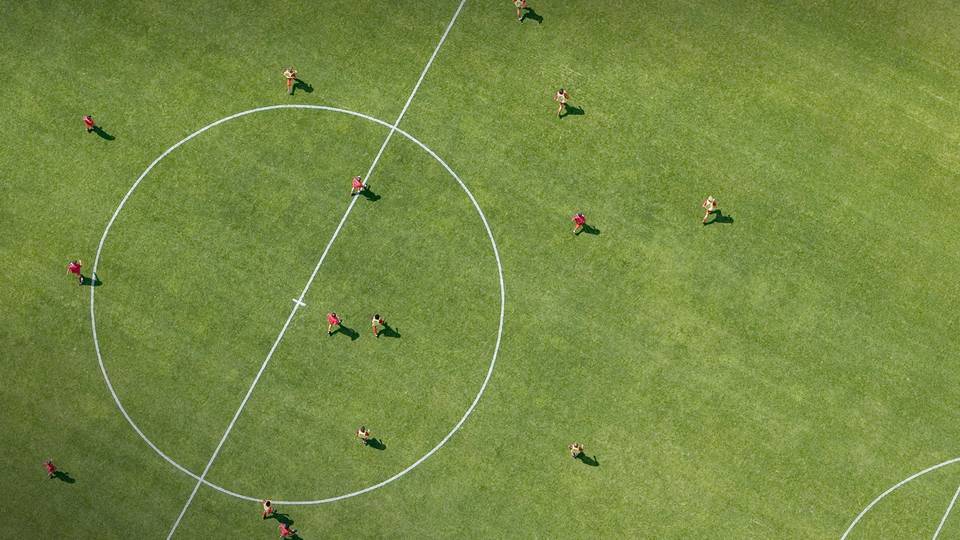Transitioning your young footballers from mini-soccer to 9-a-side formats requires thoughtful organisation and understanding of formations. Nine-a-side football introduces players to the offside rule, larger pitches, and expanded goals, serving as an essential bridge between small-sided games and the full 11-a-side experience. The right 9v9 formation provides crucial structure and shape to your team, allowing players to develop positional awareness while maintaining appropriate spacing on the larger pitch.
Coaches have several effective formation options to consider, including the defensive 3-4-1, the balanced 1-3-2-3, and the counter-attacking 4-3-1. Each formation offers distinct advantages depending on your squad's strengths and playing philosophy. When selecting your approach, it's important to assess which setup best accommodates your players' abilities while providing developmental opportunities.
Understanding both in-possession and out-of-possession principles for your chosen formation helps players grasp their responsibilities in different game situations. This foundational knowledge builds tactical awareness that will benefit young players throughout their football journey, regardless of which formations they encounter as they progress to 11-a-side football.
Basics of 9 Aside Football
Nine-a-side football bridges the gap between small-sided games and the full 11-a-side format, offering young players a crucial developmental step in their football journey. This format maintains key elements of the traditional game while adapting to younger players' capabilities.
Understanding the Pitch
The 9-a-side pitch is significantly smaller than a full-size football pitch. Standard dimensions typically range from 70-80 meters in length and 40-50 meters in width. This reduced size is deliberately designed to suit younger players' physical capabilities while still providing enough space to develop proper tactical awareness.
The goals are also smaller, usually measuring 7 meters wide by 2.1 meters high. This adjustment helps young goalkeepers defend more effectively based on their height and reach.
Corner flags, goal areas and penalty areas are all included, though scaled down proportionately. The penalty spot is positioned 9 meters from the goal line, compared to the 12 meters in 11-a-side football.
The Rules of the Game
Most standard football rules apply in the 9v9 format, with some key modifications. Match duration is typically shortened to 30-35 minute halves, depending on the age group. Substitutions are often rolling, allowing players to re-enter the game after being substituted.
The offside rule is implemented in 9-a-side, introducing young players to this crucial concept. This helps prepare them for the tactical aspects of the full-sized game.
Ball sizes vary by age group, with sizes 3-4 commonly used instead of the adult size 5. Team formation typically includes one goalkeeper and eight outfield players arranged in various systems such as 1-3-2-3, 1-3-3-2 or 1-2-3-3.
Throw-ins, goal kicks and corners follow standard football procedures, helping players learn proper techniques and strategies in a more manageable environment than the full 11-a-side soccer format.
Organising Competitions
Successfully running 9-aside football competitions requires careful planning and administration. A well-structured competition keeps players engaged and ensures matches run smoothly throughout the season.
League Structure
Creating an effective league structure forms the foundation of any successful competition. For 9v9 formats, consider dividing teams into divisions based on ability levels if you have sufficient numbers. A standard league typically includes 8-12 teams, allowing for a balanced season without too many or too few fixtures.
Points systems should be clearly established from the outset. The traditional approach awards three points for a win, one for a draw, and zero for a loss. Include tie-breakers in your rules to determine final stats when teams finish on equal points.
Consider implementing promotion and relegation between divisions to maintain competitive balance season after season. This keeps matches challenging and engaging for all participants.
Always prepare and distribute a comprehensive league handbook containing rules, contact information, and disciplinary procedures before the season begins.
Scheduling Fixtures
Effective fixture scheduling ensures all teams receive a fair and balanced playing calendar. Begin by determining your competition timeframe, considering holidays, school terms, and potential weather disruptions.
Create a master fixture list using scheduling software or spreadsheets. For smaller leagues, a simple round-robin format works well, where each team plays all others once (single round-robin) or twice (double round-robin).
Consider these key factors when planning your schedule:
- Pitch availability and maintenance
- Referee assignments
- Time between matches for each team
- Travel requirements for away teams
- Balance of home and away fixtures
Publish the fixture list well in advance, giving teams at least 3-4 weeks' notice. Update your league website or communication channels with upcoming fixtures, ensuring all participants stay informed.
Handling Postponements and Cancellations
Even the best-organised competitions face disruptions from weather, pitch conditions, or team issues. Establish clear procedures for postponements in your league rules to minimise confusion.
Set a notification timeline for postponement requests (e.g., minimum 48 hours before kickoff) except for emergencies or weather-related issues. Designate who makes final decisions on postponements—typically the league administrator or referee for weather/pitch conditions.
Maintain a regularly updated league table showing recent results and accounting for any postponed matches. This transparency helps teams understand their standing despite schedule disruptions.
Create a rescheduling protocol that prioritises fairness. Reserve several "catch-up" dates in your calendar specifically for rearranged fixtures. When significant fixture backlogs develop, consider midweek matches or doubleheaders if appropriate for your age group.
Keep accurate records of all postponements, including reasons and rescheduled dates, to maintain league integrity.
Matchday Essentials
Preparing thoroughly for your 9-aside football matches can make the difference between a chaotic experience and a well-organised event. Having the right equipment, understanding tactical approaches, and ensuring clear team communication are vital components of successful matchday management.
Team Formations and Tactics
When planning for 9v9 matches, selecting the right formation is crucial to maximise your team's strengths. Common formations include 3-2-3, 3-3-2, and 3-4-1, each offering different strategic advantages.
The 3-2-3 formation provides good width and attacking options while maintaining defensive stability. This balanced approach works well for teams with versatile players who can transition between attack and defence.
For teams with strong midfielders, the 3-3-2 formation offers enhanced control in the middle of the pitch. This setup helps dominate possession while still providing adequate defensive coverage and forward options.
Teams prioritising defensive solidity might opt for a 3-4-1 formation. This approach creates a strong midfield barrier while relying on quick counter-attacks and a single forward who can operate independently.
Tactical flexibility is important. Prepare your players to adjust formations based on match situations, opponent strategies, and game progression.
Key Roles and Responsibilities
Every position in 9-aside football carries specific responsibilities that players must understand clearly.
The goalkeeper serves as both shot-stopper and the first point of attack. They need good distribution skills and communication ability to organise the defence effectively.
Defenders should focus on positioning, communication, and simple clearances. In 9-aside, the defensive line must work as a cohesive unit to compensate for the wider pitch relative to player numbers.
Midfielders act as the team's engine, balancing defensive duties with supporting attacks. They need stamina, positional awareness and good passing skills to link play effectively.
Forwards must be clinical with finishing opportunities while also contributing to pressing from the front. Teaching forwards when to hold up play and when to make runs is essential.
Designate a captain who can relay instructions and maintain team morale during challenging moments in the match.
Importance of Possession
Maintaining possession in 9-aside football creates control and reduces defensive pressure on your team.
Teaching players to prioritise ball retention through short, simple passes helps establish rhythm and confidence. Encourage players to look for the easy option rather than forcing risky passes.
Creating triangles across the pitch gives the player in possession multiple passing options. This geometric approach to positioning makes it easier to maintain possession even under pressure.
The goalkeeper and defenders should be comfortable receiving and distributing the ball. Building attacks from the back draws opponents forward, creating space to exploit elsewhere.
Transition moments are critical. When possession is lost, immediate pressure on the ball carrier can prevent counter-attacks and help regain possession quickly.
Balance is key—possession without purpose doesn't win matches. Players should recognise when to circulate the ball patiently and when to increase tempo and play more directly.
Scoring and Keeping Score
Accurate record-keeping is essential for tracking team and individual performance in 9-aside matches.
Bring a scorebook or digital tracking system to log goals, assists, and notable performances. This information proves valuable for identifying patterns and areas for improvement in subsequent training sessions.
Designate a reliable person to maintain the score and record key match events. This individual should also track playing time to ensure fair rotation if using substitutes.
For youth teams, emphasise development over scorelines. While winning is enjoyable, skill development and enjoyment should remain the primary focus in grassroots soccer.
Set realistic scoring targets based on your team's abilities and the opposition's strengths. This creates measurable objectives beyond simply winning or losing the match.
Recording match statistics helps identify trends that might not be obvious during play. This data can inform future tactical decisions and training priorities.
Prominent Teams and Influences
The landscape of 9-aside football features several standout teams that have shaped the development of this format through innovative tactics and consistent performance. These teams have contributed to regional variations and cultural impacts that continue to influence how the game is played at grassroots level.
Spotlight on Notable Teams
Ajax Youth Academy has pioneered 9v9 developmental approaches, adapting principles from their famous "Total Football" philosophy to smaller-sided games. Their emphasis on positional fluidity and technical skill development has been widely adopted across European youth systems.
Kings FC from Manchester has dominated regional 9-aside tournaments for three consecutive seasons, implementing a high-pressing system that maximises the smaller pitch dimensions. Their tactical blueprint has become a case study for grassroots coaches.
Latino Heat A, based in South London, has gained recognition for their distinctive possession-based approach, often fielding players with South American heritage who bring creative flair to the format.
The Hackney Rovers have successfully translated their 9-aside tactics to full-sided success, with several players progressing to semi-professional contracts.
Cultural and Regional Impact
In Scotland, 9-aside football has developed a more direct playing style compared to English counterparts, with teams like Glasgow United emphasising physical development and transition play. This regional variation demonstrates how the format adapts to local football cultures.
Several inner-city communities use 9-aside leagues as community engagement tools. The East London Soccer Alliance, comprising 24 teams from diverse backgrounds, provides competitive opportunities while promoting social cohesion.
The format has seen particular growth in areas with limited playing space. Welsh border counties have embraced 9-aside competitions due to geographical constraints, creating distinctive tactical approaches that maximise narrow pitches.
Tournament organisers increasingly recognise cultural diversity, with the Birmingham International Youth Cup featuring dedicated 9-aside categories that attract teams from across Europe and beyond.












